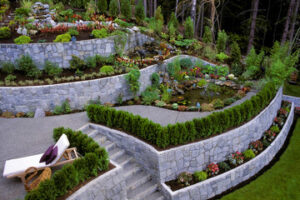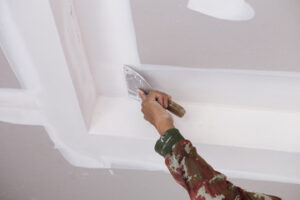Nothing sinks a homeowner’s heart faster than shoddy hardscape work. Retaining walls that collapse, patios that settle and deteriorate, and water features that don’t hold up to the elements can all be expensive headaches to deal with.
Proper maintenance for these outdoor features is key to keeping them in great shape and saving time (and money) on yard care. Visit https://vantaoutdoors.com/ to learn more.
Most people think of landscaping, luscious flower beds, lush gardens, and vibrant vines. While these organic components are an integral part of any landscape, there is also a growing interest in hardscaping, which is the non-horticultural parts of your yard. This is because hardscapes provide a unique aesthetic and functional advantage.
While hardscapes may sound intimidating, they are actually very easy to incorporate into your landscape. Even a small backyard can benefit from the addition of hardscape features. A few examples of hardscaping include a patio, which provides a space for relaxing or dining al fresco, a pathway made from natural stone or concrete to prevent you from stomping through and getting your shoes dirty, and a designed outdoor fire pit which can enhance the overall beauty of your landscape.
Other hardscaping elements you can consider include stone retaining walls which allow you to plant on a sloped yard, water-centric features such as fountains or pools which add both beauty and function, and walkways that connect different areas of your garden. The use of hardscape materials allows you to create a comfortable, outdoor environment that can be enjoyed year-round, regardless of the climate.
The best part about hardscape is that it can complement your horticultural landscape, rather than compete with it. Choosing the right materials and designing your hardscape to fit your landscape will ensure that it looks like it has always been a part of your yard. You may even choose to match your hardscape with the exterior of your home, which can help it blend into the surroundings and make your yard appear larger and more spacious. The choice of materials for your hardscape will also play a role in how much maintenance it requires. For instance, bricks will likely require more upkeep than gravel or stone.
Functionality
When people hear the word “landscape,” they usually think of flowers, trees, and shrubs—but hardscape is equally as important. Hardscape refers to the non-living portions of landscaping, which is made up of paved areas, fencing, paths, patios, decks, and more. Many beautiful properties find a way to integrate both hard and soft landscapes into their design. When done well, these two environments can work in harmony to create a stunning space for living and playing.
The best part about hardscape is that it’s more than just a pretty addition to your yard. From gazebos to retaining walls, there are many different ways that you can incorporate these features into your outdoor space to make it more functional and stylish. For example, a walkway can add an extra element of style to your garden, while a stone bench is the perfect place to relax. Incorporating these elements into your home’s exterior will make it stand out from the rest and give potential buyers an impression that you have taken good care of your property over the years.
Another great feature of hardscape is its ability to increase the livability of your home. For example, a gazebo can provide a cozy spot to sit in the sun or read a book. Alternatively, a patio can be the ideal setting for a family dinner or backyard barbecue.
Hardscape is also the foundation of much of our city infrastructure, such as sidewalks, gutters, and streetlights. These structures are designed to manage the flow of people, traffic, and water in a practical and attractive manner. Urban ecologists are increasingly recognizing these functions of hardscape as part of a broader system of nature.
Durability
When designed and installed correctly, hardscapes can be long-lasting. However, the longevity of hardscapes can vary considerably, depending on factors such as regional climate and the materials used. For instance, stone such as limestone, sandstone and travertine are extremely durable choices for patios but may not be ideal for driveways in the Southeast due to freeze thaw cycles that cause expansion and contraction of the material.
Concrete pavers offer another great option for durability, as well as a wide range of color and texture options. They are a great choice for patios, walkways and walls and can even be stamped with different patterns/textures to mimic other materials. Concrete is also very affordable and can be customized for a particular look with the use of borders and other accents.
One important factor for hardscape durability is proper drainage. If water is allowed to pool on or under hardscape surfaces, it can damage them and create a slick surface that’s unsafe for pedestrians and vehicles alike. The best hardscape designs direct rainwater into specific areas on the property where it can be absorbed into soil, rather than being directed into sewer systems and washed into nearby rivers or lakes.
Other functional hardscapes that can add beauty to the outdoors include tree grates, trench drains, stormwater grates, gratings and bollards that define spaces, support planters, and protect trees and plantings. Increasingly, these pieces of functional hardware are being seen as critical elements for urban revitalization by using them to support new kinds of green infrastructure.
Whether it’s natural stone, wood or concrete, all hardscapes require regular maintenance to ensure their longevity and keep them looking their best. Peak’s skilled professionals provide inspections, cleaning and sealing services that will protect your investment and help extend the life of your hardscapes.
Curb appeal
When you make an investment in hardscaping, curb appeal is often an added benefit. In fact, research shows that homes with attractive exteriors sell for seven percent more than similar properties with less inviting exteriors. This is because a well-maintained and well-designed outdoor space can inspire positive assumptions about the home’s interior. This “halo effect” can even mask minor disconfirming information, such as wear and tear on carpeting or a slightly worn sofa, in the buyer’s mind.
The best way to maximize your home’s curb appeal is by coordinating the color of your hardscape features with the color of your house. If you have an orange house, for example, add some red elements in your landscaping to draw attention. A pop of color also makes the front entryway more welcoming for visitors. If you’re unsure how to incorporate color into your landscape, consult with a hardscape designer.
Another way to boost curb appeal is by creating a well-defined walkway. This can be achieved by using brick and stone for your sidewalks, and it will help to improve the accessibility of your property. A hardscape design expert can help you create a walkway that compliments the shape of your home and accentuates its lines.
Adding some hardscape elements can also enhance your property’s greenery and biodiversity. For example, permeable hardscape materials allow rainwater to soak into the soil instead of flooding sewer systems and washing toxins into waterways. This type of landscaping is called xeriscaping, and it’s often incorporated into hardscape designs, as it requires little or no irrigation. It can also reduce the need for fertilizers and pesticides, which are harmful to the environment.
Maintenance
While most property managers focus on keeping the organic components of a landscape in shape, hardscape often gets neglected. This is largely because hardscape is permanent and doesn’t require fresh mulch or plant material on a regular basis. However, a well-maintained hardscape can add beauty and functionality to the outdoor environment for years to come.
It is important to regularly inspect and clean a hardscape, especially after severe weather events or heavy rainfall. This can prevent damage or premature wear to the materials and ensure that the walkways, patios and walls are functioning correctly. It is also a good opportunity to catch any issues early before they become costly repairs, such as cracking or sinking.
In addition, it is important to inspect a hardscape for any weed growth or other signs of degradation. Weeds can push their way between the joints of pavers, bricks and other materials, causing uneven surfaces that are difficult to walk on. This may result in injuries for staff and customers.
Finally, it is important to ensure that a hardscape has proper drainage. Without an adequate drainage system, water can seep into the joints of pavers or stones, causing them to break apart over time. Poor drainage can also cause wet rot in wood elements, foundation problems for the home or business, and flooding on the property.
Hardscape maintenance also involves sweeping and hosing down the surfaces regularly to remove dirt and debris. Sweeping is especially critical during the autumn months when leaves and other yard waste decompose on the surface, resulting in mold and stains. Additionally, it is important to sweep frequently in areas that are used for walking. Ideally, this should be done with a pressure washer to avoid damaging the pavers or stones.


